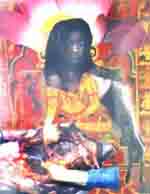International Art Exhibition.

International Art Exhibition. is an event that took place between 08-May-2001 and 16-May-2001 in Hyderabad.
-
Venue
-
Date/Time
-
Type
-
Price
-
Add New Field:
REVIEW FOR INTERNATIONAL ART EXHIBITION.
The day when art rescued its patrons finally came. The response did not give it a dream start, but usually such purposes are gradual in their effect. This one did not prove to be any exception.
The International Art Exhibition, in support of the crafts people of Gujarat and Kutch, was opened to the public with great expectations, but with its being presented in the month of May, the purpose does not seem have been realized, courtesy the vacation mood. Even the social trappings of Zareer Patell's jazz piano recital did not really pull the crowd.
Nevertheless, the exhibition has introduced a number of artists from across the globe. Chitra Ganesh and Zarina Hashmi from New York, Samantha Harrison, Rahul Bhushan and Bari Kumar from Los Angeles, Rita Bila from Sydney, Tamara Sanowar-Makhan from Toranto and Anna Bhushan from London comprised the international category. And Indian artists weren't lacking in number either: Anita Dube from New Delhi, S G Vasudev, Pushpamala N, Sheela Gowda, Ayesha Abraham, Biju Joze and Surekha from Bangalore, and Illango from Chennai comprised the group of our own donors.
And as for Hyderabad, the younger artists showed more generosity then the older generation - Sajid Bin Amar, Lakshamana Murthy, Srinivasa Chari, Nicola Durvasula, Hamid Bin Amar and Fawad Tamkanat contributed works for the cause.
The exhibition, besides serving a cause, was an eclectic display that mounted prints to paintings to photographs. A small painting by Sajid Bin Amar was an interesting icon of the 'burakh', a local icon generally seen in the dargas. The miniature assortment of graphics by Anna Bhushan appealed to the eye as it brought out images that seemed to be part of the diary of this London based artist. Trained as an illustrator, she engages a refinement in her utterances and images.
Bira Kumar's "Darkee" was the most striking print in the display. A pointer to racial discrimination, the work is a poignant image of a Blackman in a simple space of citric yellow. The dark skin is, in fact, mellowed down by the juxtaposition of his bold coloring with it, and is meant to displace the significance of color and racism.
Then Rita Bila's jigsaw layout of Indian mythic images was a captivating visual. The most evoking work was that of Zarina Hashmi, who sent in the draft of her father's ancestral home in Lahore, Pakistan. This was a simple image that narrated strong nostalgia. Every segment of the quarter uttered the existence of a memory: the mango tree, the father's living room, the berry tree and myriad other things. The Urdu script and description was used by the artist as a very strong visual statement.
Anita Dube's photo images indicate a dual aspect of her workouts - one is her preoccupation with photo documentation and the other is her penchant for assembling convincing but contradicting images. The operating tools against a flabby stomach and her 3 boxes superimposed upon the photo images of hands decorated with multiple eyes create a usual visual.
Sponsored by the ITC Kakatiya Sheraton and Towers, Indiagallery.com and Lakshana Art Gallery, the show was curated by independent curator Rasna Bhushan.
AA
USER REVIEWS FOR INTERNATIONAL ART EXHIBITION.
Be the first to comment on International Art Exhibition.! Just use the simple form below.
LEAVE A COMMENT
fullhyd.com has 700,000+ monthly visits. Tell Hyderabad what you feel about International Art Exhibition.!
MORE EVENTS IN THIS PERIOD
ALL EVENT CATEGORIES
SEARCH EVENTS
Dissatisfied with the results? Report a problem or error, or add a listing.
ADVERTISEMENT
SHOUTBOX!
{{ todo.summary }}... expand »
{{ todo.text }}
« collapse
First | Prev |
1 2 3
{{current_page-1}} {{current_page}} {{current_page+1}}
{{last_page-2}} {{last_page-1}} {{last_page}}
| Next | Last
{{todos[0].name}}
{{todos[0].text}}
ADVERTISEMENT
This page was tagged for
Lakshana Art Gallery events
May 2001 events
hyderabad arts
hyderabad exhibitions
hyderabad paintings